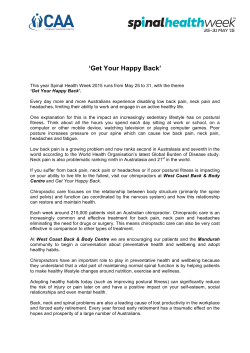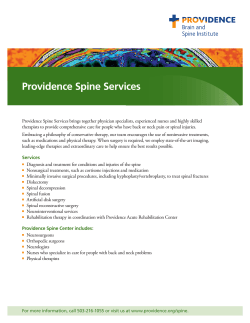
Document 17937
Zou know the feeling. You'restuck at your desk for Y hours on end. When you finally get up to grab a coffee,it hits you like lightning. Your back stiffens I and achesfor the nexthour.The sharppain seemsto travel down your legs.It s killing you. Don't sit it out - it'syour backcallingout for help,from yearsof abuseand poor posture.Thankfully,lots of studies havebeen doneto showhowyou can avoidthe problem and relieveit, becausebackpain is common:About one in five suffersfrom back and neck pain, according Singaporeans to a studydoneby The Back Societyof Singapore. \ Offtce woes Let's face it. No one is built to sit behind a desk punching at the keyboard for more than six hours a day. Sadly, it's one of the side effects of modern office work. And because more women than men take on such deskbound work, it puts us at greater risk. A recent survey by the Singapore General Hospital (SGH) on the prevalence of workrelated rnusculoskeletal disorder among office executives found that women (79 per cent) suffered the most frorn pain in comparedto BaCk pain iheback,neckandshoulders the lower back. Then there is another kind of load that is peculiar to women. The risk of back pain is higher in busty women because of the altered centre of gravity - as if sire were carrying heavy bags every day. It's worse if the breasts are built on a small frame. Take 20-year-old property agent Ada, for instance, who is petite and bosorny - a figure that is the envy of rnost wornen. But she has been suff'ering frorn rniddle back pain and rnuscle strain in her shoulder and neck for years. A visit to an orthopaedic specialist for postural advice and reconditioning exercisesto irnprove the rnuscular support and stability of the lower back didn't help, as the pain carne back. Eventually, she opted for breast reduction surgery. Pregnancy brings its joys but also back pain in rnany women. In fact, for every three mums-to-be, two will experience it. 'As the uterus and abdornen enlarges, gravity causes the ballooning belly to sag downwards, causing a strain on the back muscles and ligaments," saysDr Joycelyn Wong, a gynaecologist at ACJ Women's Clinic at Thornson Medical "Because Centre. of honnonal changes, the ligarnents tend to be more lax in pregnancy, rnaking them - lOWefS moreproneto injuryJ' thera andstrrinks o^"*:il',",?ln#T,#'il%:il1, ;nJ3?l'ffi?;'],tfT:i[i;i,T::lJl (pregnancy, when is larger, domestic work, situational childcare)and cyclical (menstrualcycles) reasons. What are the dangersof leavinga bad backunattended? the bfain bVr 11 I I pef Cent. "Pain, as a stressor,can affect the individual's ability to concentrate and also affect one's short-term memory," says Farzad Hafezi, registered physiotherapist at DBC Active Spine Care. These conditions cannot possibly be helpful "chronic to your work. Neglect your back further, and back pain can be debilitating, interfering with worklife and social life", warns Dr Chong Kian Chun, associate consultant at the Departrnent of Orthopaedic Surgery of "It also has psychological Changi General Hospital (CGH). impact. Some patients end up with depression-like symptorns. This can be a cause of mental deterioration." Even if you think the pain you feel is still not severe enough for irnrnediate treatment, don't put it off for too long. MRI research conducted last year by Northwestern University in the US found that back pains lowered the subjects' IQ, and that chronic back pain shrank the brain by as rnuch as ll per cent - that's equivalent to 10 to 20 years of grey matter lost through normal ageing! Being a woman can be a pain Worneiis work is just one reason^we are prone to bad backs. Let's start with our high heels. They don't call them "killer heels" for nothing. Tottering about on stilettos affects the lower back as it forces the upper body to arch backwards to prevent the person from falling forwards. This adds stress to the neck, shoulders, and upper and lower back. Considering that the average adult walks at least 20,000 steps a day, it's wise to alternate your heels with flats every other day. Lugging a heavy handbag around will also stress the tummy somecAnoccur earlier,at 20 weeks. To keep backachesat bay, says Dr Wong, invest in a good rnaternitybelt or support girdle; and sleep on the side or with your knees bent with supporting pillows. For acute back-pain sufferers, there are pregnancy-safe painkillers, anti-rnuscle ache topical creArns, physiotherapy, hotpacks or massages.When baby is here, maintain a good posture while breastfeeding, bathing or bending down. For others like Rebecca, 32, who suffered from lower back pain during her pregnancy, she sought Core Concepts for help. The centre cornbines physiotherapy rnanual treatrnents and massageswith core stability training that target the deepest layer of abdorninal rnuscles. To help Rebecca, core stability exercisesstrengthened her deep abdominal muscles to better support the spine. After delivery, she found that carrying her baby during breast-feeding forced her into a slouching posture and caused her neck muscles to strain. So she continued manual treatments (where physiotherapists work on the joint, nerve and spine) to relieve the tension and pain, and core stability exercises to prevent recurrence of chronic back pain. These were done two to three tirnes a week. "We work with clients who have weak innerrnost sets of core (abdominal) muscles or those who are unable to activate their muscles (like when you try to do a situp)," explains Sylvia Ho, senior physiotherapist at Core "Our aim is to irnprove endurance, control and Concepts. strength in the spinal colurnn, shoulder blades and neck structure through gentle exerciseswhicl'r specifically target the core muscles." Straighten up and sit right If youiback is in^good shape.tiy to keep it tlrat way by maintaining good posture. t october 2q)5 373 herworld bodv & soul "Poor posture is one of the major causes of musculoskeletaldisorder... because of prolonged sitting at the desk, often hunched over a computer keyboard," affirms Dr Tan SeangBeng, head of the Department of Orthopaedic Surgery at SGH and president of The Back Society. Bet you didn't know that sitting is worsethan standing when it comesto putting stresson the spinal discs (which act as shock-absorbersof the spine)? That's why regular stretching breaksat work will help to relax the lower back and reduce lower back pain. Why not just kick up your heels and lie back? In the 80s, it was believed that if somebodyhad back pain, she shouldstayawayfrom all activity and havecompleterest in "active bed. Today, rest" is encouraged.Continuedphysical therapy or physiotherapysuch as.documentationbasecare (DBC), core stability training and chiropractic medicine are commonly adopted as part qf a patient's routine. All three are forms of physiotherapy and are non-invasive (read: no surgery).They all aim to encouragethe body to heal itself by reconditioning and strengthening its back through rehabilitative exercisesand devices. DBC includes customisedexercisesand devicesthat look Iike gym machines to improve the patient's muscle function, endurance and tissue adaptation. Ligaments, tendons and muscles in the back are encouraged to grow stronger and will be able to tolerate repetitive and prolonged strain better, not to mention protect your back in caseof an accidentor trauma to the back. 1*" d Seek treatment earlv Back-pain sufferers not keen on exercisingmay consider chiropractic medicine. One of the oldest forms of natural healing practised in the US, chiropractic ensuresthat the nerves, bones, musclesand joints work in slmc together. It works on the premise that spinal misalignment- where the spinal bone is improperly positionedor a spinaljoint is improperly moved- can causenerve pressureor irritation. "Nerves travel from the spinal cord through openings on either side of the spine to get to all of your cells and organs," explains Dr Greg McRae, a chiropractor at Advanced Chiropractic. "The chiropractor's role is to locate the source of the nerve dysfunction, then correct or adjust the joints in the spine to lessenthe pressure on the nerves and allow the nervous system to function normally."This is called "spinal manipulation",and can be aided by physiotherapytreatments such as electrotherapy or ultrasound. In Traditional Chinese Medicine, lower back pain, also known as waist ache, is caused by the blockage of chi (internal energy) brought on by the imbalance of yin andyang (vital energies),such as over-exertion,emotional upheavalslike depressionand anger,over exposureto heat and cold, external injuries like sprains and insect bites, and eating the wrong foods. The waist is "house" to the kidneys,sopain in the areaimpliesthat somethingmaybe wrong with the kidneys. Er.ly diagnosisenablesback pain to respondbetter to physicaltherapy and medication. Dr McRae says:"Spinal problems,if left unchecked a long time' can lead to many other problems in the ,, "-"-,:: body such as irritable bowel syndrome,dizziness,fatigue, headaches, asthma,and visualproblems." Says Dr Teh Peng Hooi, a consultant orthoepaedic surgeonin private practice: "Those who come to me at a later stage already have unbearable pain and restrictive movement whereby they can't walk or get out of bed. They require medication, mostly painkillers and antiinflammatorydrugsto relievethe pain and spasm. "Part of treating back pain is analysing where the pain is coming from by talking to the patient, physical examination, x-ray and physiotherapy. Surgery only comesas a last resort, like in casesthat do not respondto medication,where there is extreme nerve damagecaused by trauma such as fractures of the spine and rupture or tearsof the spinaldiscs." Why wait till things hit such a severestage?"There is fear amongback-painsufferers,"explains Hafezl "so they avoidactivity and chooseto stayin bed. The individual must take the bull by the horns and do somethingaboutit, rather than lie down and wait for the problem to go away." Hw
© Copyright 2025





















